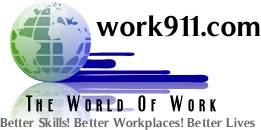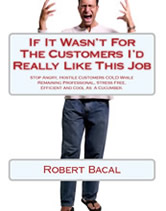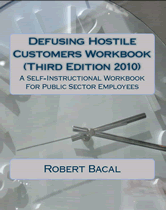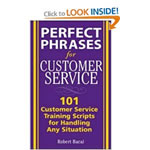
Organizational Conflict - The Good, The Bad & The Ugly
This article is one of the most requested when people ask to reprint Robert Bacal's material. It clarifies that there are different kinds of conflict, and even some conflict that is even beneficial and productive. But there is also bad conflict, and then really ugly personalized conflict. If you enjoy this article and wish to learn more about cooperative communication be sure to check out our quick read book called "Conflict Prevention In the Workplace - Using Cooperative Communication" by clicking here
In my work with public sector managers and supervisors, the issue that generates the most emotion, and frustrated comments, is conflict within the organization. We generally do not look at conflict as opportunity -- we tend to think about conflict as unpleasant, counter-productive and time-consuming. Conflict that occurs in organizations need not be destructive, provided the energy associated with conflict is harnessed and directed towards problem-solving and organizational improvement. However, managing conflict effectively requires that all parties understand the nature of conflict in the workplace.
In this first part of our organizational conflict series, we are going to discuss several views of conflict. In later issues of The Public Sector Manager we will return to the topic with more specific tips on how organizational conflict can be directed to achieve positive ends.
| If you enjoy this article and wish to learn more about cooperative communication be sure to check out our quick read book called "Conflict Prevention In the Workplace - Using Cooperative Communication" by clicking here |
Two Views: The Good, The Bad
There are two ways of looking at organizational conflict. Each of these ways is linked to a different set of assumptions about the purpose and function of organizations.
The Bad
The dysfunctional view of organizational conflict is imbedded in the notion that organizations are created to achieve goals by creating structures that perfectly define job responsibilities, authorities, and other job functions. Like a clockwork watch, each "cog" knows where it fits, knows what it must do and knows how it relates to other parts. This traditional view of organizations values orderliness, stability and the repression of any conflict that occurs. Using the timepiece analogy we can see the sense in this. What would happen to time-telling if the gears in our traditional watches decided to become less traditional, and re-define their roles in the system?
To the "traditional" organizational thinker, conflict implies that the organization is not designed or structured correctly or adequately. Common remedies would be to further elaborate job descriptions, authorities and responsibilities, increase the use of central power (discipline), separate conflicting members, etc.
This view of organizations and conflict causes problems. Unfortunately, most of us, consciously or unconsciously, value some of the characteristics of this "orderly" environment. roblems arise when we do not realize that this way of looking at organizations and conflict only fits organizations that work in routine ways where innovation and change are virtually eliminated. Virtually all government organizations work within a very disorderly context -- one characterized by constant change and a need for constant adaptation. Trying to "structure away" conflict and disagreement in a dynamic environment requires tremendous amounts of energy, and will also suppress any positive outcomes that may come from disagreement, such as improved decision-making and innovation.
The Good
The functional view of organizational conflict sees conflict as a productive force, one that can stimulate members of the organization to increase their knowledge and skills, and their contribution to organizational innovation and productivity. Unlike the position mentioned above, this more modern approach considers that the keys to organization success lie not in structure, clarity and orderliness, but in creativity, responsiveness and adaptability. The successful organization, then, NEEDS conflict so that diverging views can be put on the table, and new ways of doing things can be created.
The functional view of conflict also suggests that conflict provides people with feedback about how things are going. Even "personality conflicts" carry information to the manager about what is not working in an organization, affording the opportunity to improve.
If you subscribe to a flexible vision of effective organizations, and recognize that each conflict situation provides opportunity to improve, you then shift your view of conflict. Rather than trying to eliminate conflict, or suppress its symptoms, your task becomes managing conflict so that it enhances people and organizations, rather than destroying people and organizations.
So, the task is to manage conflict, and avoid what we call "the ugly"....where conflict is allowed to eat away at team cohesiveness and productivity.
The Ugly
We have the good (conflict is positive), the bad (conflict is to be avoided), and now we need to address the ugly. Ugly occurs where the manager (and perhaps employees) attempt to eliminate or suppress conflict in situations where it is impossible to do so. You know you have ugly in your organization when:
- many conflicts run for years
- people have given up on resolving and addressing conflict problems
- there is a good deal of private bitching and complaining but little attempt to fix the problem
- staff show little interest in working to common goals, but spend more time and energy on protecting themselves
When we get "ugly" occurring in organizations, there is a tendency to look to the manager or formal leader as being responsible for the mess. In fact, that is how most employees would look at the situation. It is true that managers and supervisors play critical roles in determining how conflict is handled in the organization, but it is also true that the avoidance of ugliness must be a shared responsibility. Management and employees must work together in a cooperative way to reduce the ugliness, and increase the likelihood that conflict can be channeled into an effective force for change.
Ugly Strategies
In future articles we will look at what you can do to proactively manage conflict to increase the probability that positive outcomes occur. Right now, let's look at some common strategies that result in the increase of ugly conflict.
Most of the ugly strategies used by managers, employees, and organizations as a whole are based on the repression of conflict in one way or another. We need to point that, in general, you want to avoid these approaches like the plague.
Ugly #1: Nonaction
The most common repressive management strategy is nonaction -- doing nothing. Now, sometimes, doing nothing is a smart thing to o, provided the decision to do nothing is well thought out and based on an analysis of the situation. Most of the time, people "do nothing" about conflict situations for other reasons, such as fear of bringing conflict into view, or discomfort with anger.
Unfortunately, doing nothing generally results in conflict escalating, and sets a tone for the organization..."we don't have conflict here". Everyone knows you have conflict, and if you seem oblivious, you also seem dense and out of touch.
Ugly #2: Administrative Orbiting
Administrative orbiting means keeping appeals for change or redress always "under consideration". While nonaction suggests obliviousness since it doesn't even acknowledge the problem, orbiting acknowledges the problem, but avoids dealing with it. The manager who uses orbiting will say things like "We are dealing with the problem", but the problem never gets addressed. Common stalls include: collecting more data, documenting performance, cancelling meetings, etc.
Ugly #3: Secrecy
A common means of avoiding conflict (or repressing it) is to be
secretive. This can be done by employees and managers.
The
notion is that if nobody knows what you are doing, there can be
little conflict. If you think about this for a moment, you will
realize its absurdity. By being secretive you may delay conflict
and confrontation, but when it does surface it will have far more
negative emotions attached to it than would have been the case if
things were more open.
Ugly #4: Law and Order
The final "ugly strategy". Normally this strategy is used by
managers who mistakenly think that they can order people to not
be in conflict. Using regulations, and power, the person using
the approach "leans on" people to repress the outward
manifestations of conflict.
Of course, this doesn't make conflict go away, it just sends it scuttling to the underground, where it will grow and increase its destructive power.
Conclusion
The notion that conflict should be avoided is one of the major contributors to the growth of destructive conflict in the workplace. The "bad" view of conflict is associated with a vision of organizational effectiveness that is no longer valid (and perhaps never was). Conflict can be directed and managed so that it causes both people and organizations to grow, innovate and improve. However, this requires that conflict not be repressed, since attempts to repress are more likely to generate very ugly situations. Common repression strategies to be avoided are: nonaction, administrative orbiting, secrecy and law and order.





